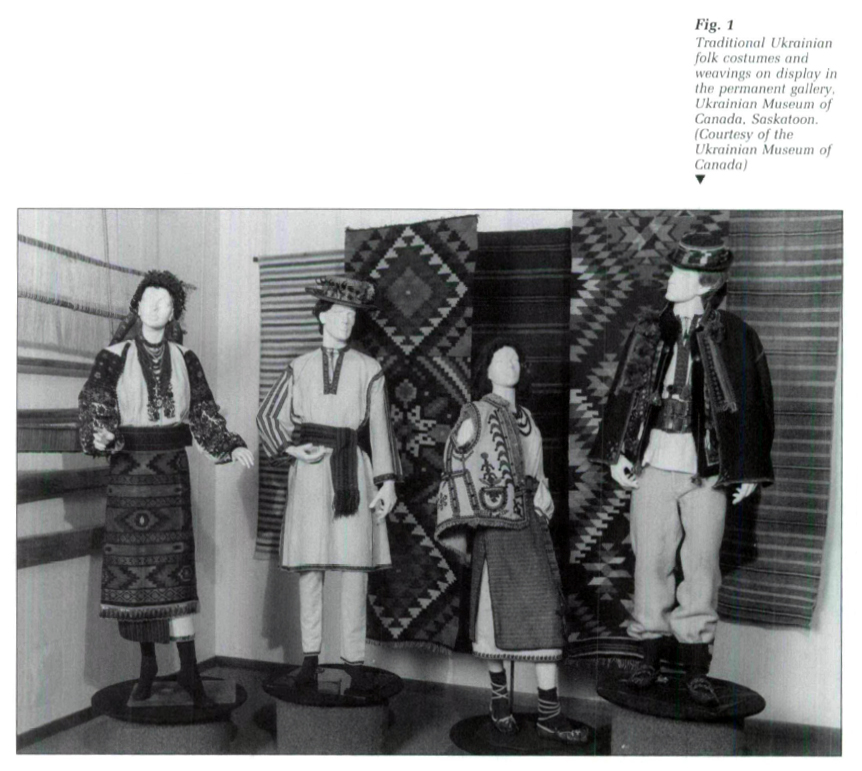Exhibitions and Collections / Expositions et collections
The Ukrainian Museum of Canada
1 The Ukrainian Museum of Canada (UMC), with headquarters in Saskatoon, Saskatchewan, is one of the country's finest specialized ethnographic museums. Four volunteer-operated branches of the UMC in Vancouver, Edmonton, Winnipeg and Toronto complete the museum network. Together, they house an outstanding collection specializing in textiles.
2 Quantitatively, the Saskatoon collection alone totals almost 30,000 items. Qualitatively, there are four components of the collection, namely, ethnographic and historical artifacts, works of art, archival materials and library materials.
3 The ethnographic and historical artifacts are subdivided into the following groups.
4 Embroidery: These include more than 500 men's and women's shirts and/or blouses (sorochky). recognizable as to region by traditional patterns, stitches and colours. As an example, garments from the Kiev region are worked in nyzynka, an embroidery pattern worked from the "wrong" side in colours of yellow, orange, red, wine, and black. The embroidery collection also contains towel (rushnyky) embroidery with ornamentation of stylized flowers, birds or geometrical design, The rushnyky are used in rites of passage (birth, death, marriage) and to decorate the home.
5 Costume items: About 2000 articles are found in this category including leather jackets or short coats (kyptari), usually associated with the Carpathian region; long coats (kozhukhy); long white scarves, hand woven, embroidered or beaded at the ends (khustyny and peremitky); wrap-around skirts (obhortky); long fitted jackets (korsetky); jewelry, footwear, and headwear.
6 Weaving: These come from almost all areas of Ukraine. Hand-loomed, beautifully designed rugs or carpets (kylymy), bench covers (nalavnyky) and woven towels form the largest part of the collection.
 Display large image of Figure 1
Display large image of Figure 17 Costumed dolls: They wear replicas of costumes from all regions of Ukraine. Each article of a costume is embroidered or decorated with appropriate and traditional designs, either woven, knitted or appliquéd.
8 Ceramics: Inherent individualism is expressed by various artists in delicate and intricate motifs executed in designs characteristic of a particular region. Utilitarian pottery and ornamental ceramics reflect the strong ties with the earth. Noteworthy are several pieces of Saskatchewan-crafted pottery, the work of Peter Rupchan, a Bukovynian immigrant. This collection was placed on permanent loan to the UMC by the Government of Saskatchewan as an integral part of Saskatchewan heritage.
9 Woodcarving (riz'ba): This art form was originally used for making household utensils and tools (cheese boards, plates, washboards, bowls) and larger structures. In the collection are woods decorated with burnt-on designs and flat wood carving, some of which are inlaid with various coloured woods, mother-of-pearl, beads, horn or metal.
10 Easter eggs (pysanky): Over 1000 richly decorated Easter eggs in more than one hundred motifs validating ideographic meaning of regional patterns make up this group. Patterns are geometric, in plant and animal motifs or designs from the Trypillian era.
11 Ritual breads: In this group are symbolic kalach, the braided bread used in most ceremonies, and korovai, a wedding bread ornamented with doves, pine cones, and greenery and/or flowers. Several intricate designs patiently formed by skilled hands awe observers.
12 Ecclesiastical artifacts: Priestly vestments, chalices, censers, crosses and icons can be found in this group.
13 Prominent in the permanent gallery, "The Sons of the Soil," is a miniature model of a house displaying an authentic architectural style with furnishings and such equipment as may be seen in a Ukrainian village home. Agricultural and household supplies, currency (coins) and festive items relating to traditions and customs enhance the authenticity of this production.
14 Among the 110 paintings in the Museum's art collection is a series of paintings executed by William Kurelek as a special commission by the Ukrainian Women's Association of Canada to commemorate Canada's centennial in 1967. The collection, titled "Ukrainian Pioneer Women," includes the following: A First Meeting of the Ukrainian Women's Association, Women Feeding the Threshing Gang, A Boorday—the First House, Ukrainian Canadian Farm Picnic, Blessing the Easter Paska, The Second House, Clay Plastering, Teaching the Sign of the Cross, Making Easter Eggs, Ukrainian Christmas Eve Feast, Teaching Ukrainian and Teaching Ukrainian Embroidery. In progress at the present time are preparations for a travelling exhibition and a catalogue of this interesting and valuable collection.
15 Subjects of 3500 slides that are in the Museum's collection include churches and other architecture, historical events and people from the past, regional costumes and crafts (weaving, embroidery, pysanka), and the Museum and its activities. A library of about thirty videotapes (VHS) encompasses a variety of titles ranging from A Traditional Ukrainian Christmas to That's My Baba and Journey in Time: Our Story, a tour of the UMC.
16 The Museum's library-research centre is the repository for about 8000 books (including branch collections). One-third of the core collection is in literature, and another third in history, arts and crafts. Other subjects include religion, music and cooking. Approximately 10,000 serial publications include mainly incomplete collections of periodicals. Most of the library collection is in the Ukrainian language. Photographic records of historic sites and points of interest related to the history of Ukrainians in Canada are also registered in the library collection. A special project to catalogue and inventory all the library collections in Saskatoon and the four branches has been recently completed. The programme was funded by the Social Sciences and Humanities Research Council and a printed catalogue has now been prepared. Because of the unique nature of the resource materials, the UMC has a valuable research capability.
17 The UMC has striven to fulfil its role of custodian of the Ukrainian heritage while recognizing that the Ukrainian experience shares many common bonds with other cultural groups. Indeed, it is committed to the principle of fostering and encouraging liaison with the general community including museums and galleries, ethnic groups, and educational and cultural institutions. Through the medium of its collections, it has proven to be an effective bridge between the past and present for Ukrainians and other cultures.